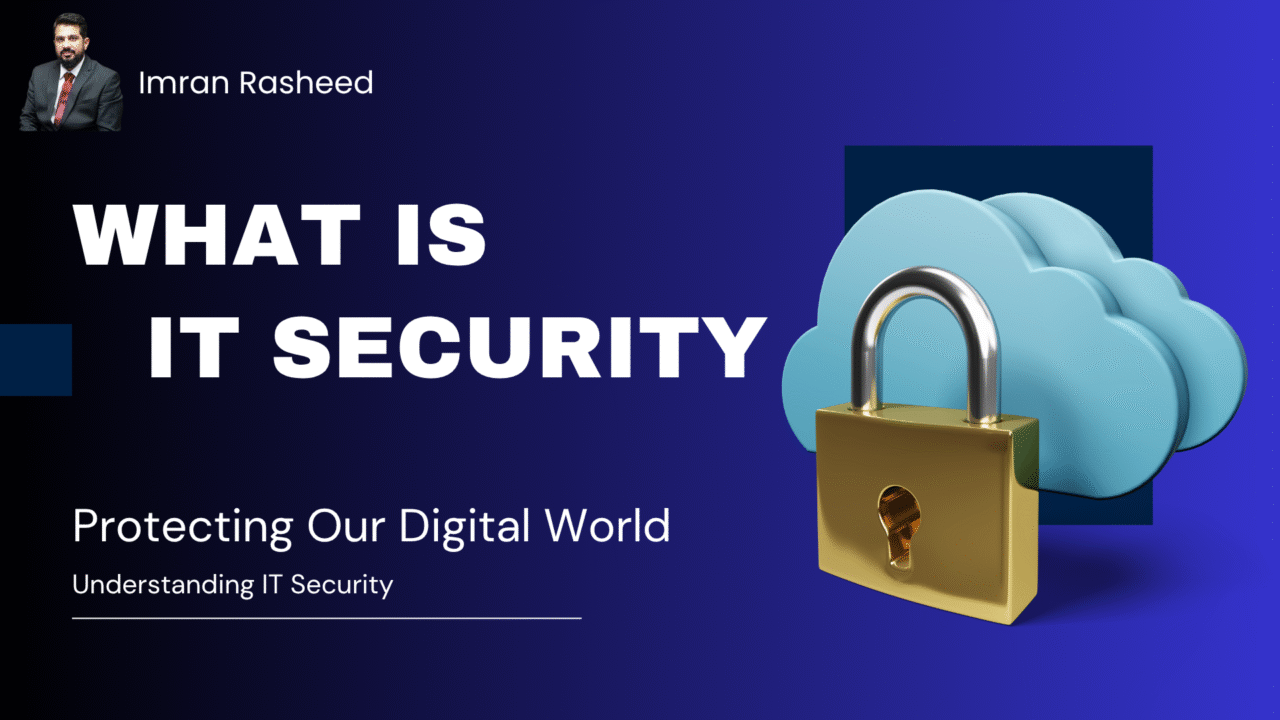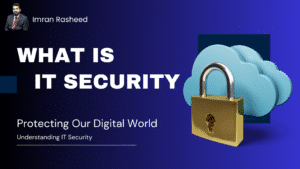
If you’ve ever wondered why data breaches make headlines so often, it’s because IT security is no longer optional; it’s essential. In today’s hyper-connected world, every click, email, and login attempt carries potential risks. IT security isn’t just about installing firewalls or antivirus software; it’s about building a resilient digital environment that protects your systems, data, and people from evolving threats.
From small startups to global enterprises, I’ve seen how the absence of a solid IT security framework can cost businesses their reputation, revenue, and sometimes, their survival. That’s why understanding IT security not just as a technical function but as a strategic necessity is crucial for every organization.
Understanding IT Security: The Foundation of Modern Digital Protection
When people ask me, “What exactly is IT security?”, I like to explain it as the art and science of keeping digital assets safe from harm. It’s the foundation of digital trust, ensuring that data remains confidential, systems stay available, and information isn’t altered or stolen.
What Does IT Security Really Mean?
At its core, IT security (or information technology security) refers to the set of strategies, tools, and best practices used to safeguard information systems from unauthorized access or attacks. It’s not just about protecting computers; it’s about protecting your entire digital ecosystem, from cloud servers to mobile devices.
How IT Security Differs from General Cybersecurity
Many people use IT security and cybersecurity interchangeably, but there’s a subtle difference. IT security focuses on protecting the integrity, confidentiality, and availability of data within an organization, while cybersecurity covers the broader battle against online threats across networks and the internet. In short, cybersecurity is the outer shield IT security is the structured defence inside.
Why IT Security Is More Than Just a Technical Practice
Good IT security isn’t achieved by technology alone. It’s a mindset. It involves culture, awareness, and accountability across every level of an organization. You can deploy the best tools in the world, but if employees aren’t aware of phishing risks or weak passwords, the system remains vulnerable.
The Core Components and Types of IT Security
When people talk about IT security, they often think of it as one big wall protecting the company. In reality, it’s more like a network of layered defenses, each designed to secure a different part of your infrastructure. If one layer fails, the others still stand. Here are the main components that form the backbone of effective IT security.
Network Security
Think of your network as the highway where data travels. Network security ensures that only authorized users can enter and move freely. Firewalls, intrusion detection systems, and VPNs are some of the common defences here. A secure network blocks malicious traffic before it even reaches your systems.
Application Security
Every business runs on software, from CRMs to mobile apps, and each app can be a target. Application security focuses on building software that’s secure by design. It involves code reviews, regular vulnerability scans, and secure development practices to prevent exploits like SQL injections or cross-site scripting.
Endpoint Security
Your laptops, desktops, and smartphones are the gateways into your business network. Endpoint security ensures those devices are hardened and continuously monitored. I always recommend solutions that combine antivirus, EDR (Endpoint Detection and Response), and remote management for complete visibility.
Cloud Security
As businesses shift to cloud environments, security responsibilities become shared between provider and client. Cloud security involves encryption, identity management, and proper configuration to prevent unauthorized access. Misconfigurations remain one of the top causes of cloud breaches today, something I’ve seen firsthand with clients migrating too quickly.
Data and Database Security
Data is often your organization’s most valuable asset. Encrypt it. Back it up. Monitor it. Database security ensures that sensitive information financial records, personal data, and intellectual property, stays out of the wrong hands. Access control and data loss prevention (DLP) tools play a key role here.
Infrastructure Security
From servers to routers to IoT devices, everything connected to your network needs protection. Infrastructure security ensures your hardware, firmware, and connected devices are configured correctly and updated regularly. A single outdated router can become the weakest link in your entire security chain.
Common IT Security Threats and Risks in 2025
The threat landscape is evolving faster than most businesses can adapt. What worked for security two years ago might already be outdated. From AI-powered attacks to human slip-ups, here’s what’s shaping the biggest IT security challenges in 2025.
Ransomware and Malware Attacks
Ransomware isn’t new, but it’s more aggressive than ever. Attackers are no longer just encrypting data; they’re stealing it before locking systems and demanding payment twice. Modern defences like endpoint detection and behavioural analysis are essential to spot these attacks early.
Phishing and Social Engineering Tactics
No matter how advanced technology becomes, human error remains the easiest door to open. Phishing emails and fake login pages still trick even tech-savvy users. The best defence here isn’t just filters, it’s regular employee awareness training and real-world simulations.
Insider Threats and Human Errors
Not every breach comes from outside. Sometimes it’s an employee who accidentally clicks the wrong link or downloads the wrong file. Insider threats, intentional or not, can expose sensitive data. Access control and role-based permissions can reduce the damage.
Cloud Misconfigurations and Third-Party Risks
As businesses scale into hybrid and multi-cloud setups, misconfigurations have become one of the top causes of breaches. A single open S3 bucket or exposed API can leak thousands of records. Always audit your cloud setup and monitor third-party vendors closely.
Emerging AI-Driven Cyber Threats
AI has changed the game both for defenders and attackers. Cybercriminals are now using AI to automate phishing, mimic human writing, and identify weak systems faster than ever. Staying secure in 2025 means using AI defensively, too, from predictive threat models to automated response systems.
IT Security vs Cybersecurity: What’s the Real Difference?
These two terms often get used interchangeably, but they’re not quite the same. Understanding their distinction helps businesses build stronger, more focused security frameworks.
Scope and Focus Comparison
IT security is broader; it protects all aspects of an organization’s information systems, from hardware and software to data and networks. Cybersecurity, on the other hand, focuses mainly on protecting digital assets from online threats. Think of IT security as the umbrella, and cybersecurity as one critical spoke within it.
Overlapping Objectives and Key Distinctions
Both aim to keep information safe, but their methods differ. Cybersecurity leans heavily on defending against hackers, malware, and data breaches, while IT security also covers access control, device management, and policy enforcement. They overlap, but their scope isn’t identical.
When IT Security and Cybersecurity Work Together
In a modern enterprise, these two functions can’t exist in silos. For example, a strong IT security policy supports cybersecurity tools by defining who can access what and how. When both teams align tech and policy, the organization achieves true digital resilience.
Why IT Security Is Crucial for Modern Businesses
Strong IT security isn’t just a technical necessity anymore; it’s a business enabler. In today’s data-driven world, a single breach can undo years of hard work and customer trust.
Protecting Customer Data and Building Trust
Every click, purchase, or form submission involves trust. Customers expect their data to be safe, and once that trust is broken, it’s hard to rebuild. Solid IT security ensures your business keeps that promise.
Ensuring Business Continuity and Compliance
Downtime from an attack isn’t just an inconvenience; it’s a financial and reputational hit. Reliable IT security frameworks help prevent disruptions and keep your business aligned with compliance standards like GDPR or ISO 27001.
Supporting Remote and Hybrid Work Environments
As teams spread across locations, protecting endpoints and networks becomes complex. A well-structured IT security system ensures employees can work securely from anywhere without risking company data.
Reducing Financial and Reputational Risks
A single data breach can cost millions, not to mention long-term brand damage. Investing in IT security upfront is far cheaper than recovering from a security disaster later.
Best Practices for Robust IT Security Management
Strong IT security doesn’t happen by accident; it’s built through consistent practices, smart tools, and an organization-wide mindset. Let’s look at what actually works in the real world.
Implement Strong Access Controls and Authentication
Start with the basics. Not everyone should have access to everything. Role-based access, MFA (multi-factor authentication), and strict user permissions can prevent most breaches before they start.
Regularly Update and Patch Systems
It’s surprising how many attacks exploit outdated software. Automate your patching process whenever possible. Think of it as routine maintenance like oil changes for your business systems.
Conduct Security Audits and Risk Assessments
A good IT security plan evolves with your infrastructure. Quarterly audits and risk assessments reveal hidden gaps and help you fix them before hackers find them first.
Train Employees on Security Awareness
Even the best firewall can’t stop an employee from clicking a phishing link. Regular security awareness training keeps your people alert and your data safer.
Adopt a Zero-Trust Architecture
Assume no device, user, or app is safe by default; that’s the core of zero trust. It’s not paranoia; it’s preparation. Every request gets verified before access is granted.
Leverage AI and Automation for Threat Detection
Modern threats move fast. AI-driven tools like SIEM or SOAR systems help detect anomalies in real time and automate response actions before the damage spreads.
The Human Element: Why IT Security Isn’t Just for IT Professionals
- IT security is no longer a responsibility limited to system administrators or cybersecurity specialists.
Every employee who accesses, shares, or stores company data contributes to the overall security posture. - A single careless click on a phishing email can undo thousands of dollars in technical safeguards.
- That’s why organizations now emphasize security awareness training alongside firewalls and encryption systems.
- Cybercriminals increasingly target human behaviour, using social engineering to bypass even the strongest digital defences.
In this sense, employees are both the first line of defence and the weakest link in IT security. - Building a culture of cybersecurity involves continuous education, accountability, and user-friendly security policies.
- When people understand why certain rules exist, they’re more likely to follow them consistently.
- The most secure companies treat cybersecurity as a shared responsibility, not a technical afterthought.
- Ultimately, IT security succeeds when everyone from executives to interns acts with digital vigilance and awareness.
The Future of IT Security: Trends to Watch Beyond 2025
The Rise of AI and Automation in Security
Artificial Intelligence (AI) and automation are reshaping how organizations detect, prevent, and respond to cyber threats. Traditional rule-based systems can no longer keep up with the speed and sophistication of modern attacks, making AI-driven tools essential. Machine learning algorithms now analyze massive volumes of network traffic to identify anomalies, predict breaches, and automate responses within seconds. Security Operations Centres (SOCs) are increasingly adopting AI-powered threat detection, automated patch management, and intelligent incident triage to reduce human error.
However, as defenders embrace AI, so do attackers using deepfakes, AI-generated phishing, and automated exploitation techniques. The future of IT security lies in maintaining a human-AI partnership, where technology accelerates defence while experts focus on strategic decision-making and complex threat analysis.
Evolution Toward Quantum-Safe Encryption
As quantum computing evolves, traditional encryption methods such as RSA and ECC face an existential threat. Quantum algorithms could one day break today’s encryption keys in seconds, rendering current security protocols obsolete.
To counter this, the cybersecurity community is preparing for the next era: quantum-safe encryption (also called post-quantum cryptography).
These new cryptographic systems are being designed to withstand attacks from quantum computers, ensuring the confidentiality and integrity of sensitive data far into the future. Global organizations and governments are already testing quantum-resistant algorithms approved by NIST (National Institute of Standards and Technology). Businesses that start adapting early to quantum-safe standards will be better positioned to protect data sovereignty and maintain long-term compliance.
Strengthening Privacy and Regulatory Frameworks
Beyond technology, the next wave of IT security innovation will focus on governance, ethics, and data privacy. With the growing complexity of international laws from GDPR in Europe to CCPA in the U.S., organizations must take a proactive approach to compliance. Consumers are also becoming more privacy-aware, pushing companies to implement transparent data-handling practices and privacy-by-design frameworks.
Future regulations are expected to standardize cybersecurity accountability, requiring organizations to disclose breaches faster, conduct real-time audits, and adopt Zero Trust architectures.
The emphasis will shift from simply “preventing attacks” to building digital trust through ethical data stewardship, resilience, and continuous monitoring.
In short, the future of IT security will blend AI innovation, quantum resilience, and human responsibility, defining how digital ecosystems stay secure beyond 2025.
Conclusion: Why IT Security Defines the Future of Digital Trust
Companies that invest in robust IT security strategies aren’t just preventing cyberattacks; they’re strengthening brand credibility, protecting customer relationships, and positioning themselves as reliable leaders in their industries.
The truth is, security sells. Clients prefer working with businesses that prove they can protect sensitive data and maintain operational integrity. Whether it’s compliance, continuity, or customer confidence, it all comes back to how secure your digital foundation is.
Partner with experts who understand not just technology, but the business impact of security, because in the digital age, trust is your most valuable currency.
Frequently Asked Questions (FAQs)
What is IT Security in simple terms?
IT security, or information technology security, is all about protecting your digital systems, data, and networks from unauthorized access or damage. Think of it as the digital version of locking your office doors but smarter, faster, and constantly evolving to stay ahead of threats.
Why is IT Security important for every business?
Because one breach can undo years of hard work. IT security isn’t just about compliance; it’s about keeping operations running, safeguarding customer trust, and protecting your company’s reputation. In my experience, businesses that take security seriously don’t just survive cyberattacks they grow stronger because clients feel safer working with them.
What are the major threats to IT Security in 2025?
In 2025, we’re seeing AI-driven cyberattacks, deepfake-based phishing, cloud misconfigurations, and insider risks taking center stage. Threats are becoming more intelligent and targeted which is why traditional firewalls alone aren’t enough anymore. Modern IT security strategies need real-time monitoring, automation, and strong access control.
How can small businesses improve IT Security affordably?
Start with the basics: strong passwords, regular software updates, and staff training. Add affordable tools like multi-factor authentication and cloud-based security solutions that scale with your growth. Many of our small business clients are surprised by how much protection they can achieve without a huge budget it’s about smart investment, not big spending.
What’s the difference between IT Security and Cybersecurity?
While both aim to protect digital assets, IT security focuses on safeguarding internal systems, infrastructure, and data integrity, whereas cybersecurity deals with defending against external online threats like hackers and malware.
Think of IT security as the entire fortress, and cybersecurity as the frontline defense. Together, they form the foundation of a truly secure organization.





